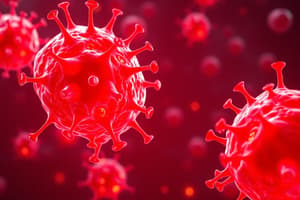Podcast
Questions and Answers
Which of the following best describes the role of physical barriers in the innate immune system?
Which of the following best describes the role of physical barriers in the innate immune system?
- They chemically neutralize pathogens in the bloodstream.
- They consist of immune cells that directly attack pathogens.
- They provide a first line of defense to prevent pathogen entry. (correct)
- They regulate the immune response through cytokine release.
Which cell type is primarily responsible for the phagocytosis of pathogens in tissues?
Which cell type is primarily responsible for the phagocytosis of pathogens in tissues?
- Natural killer (NK) cells
- Mast cells
- Dendritic cells
- Macrophages (correct)
What distinguishes innate immune cells from T and B cells in terms of their origin?
What distinguishes innate immune cells from T and B cells in terms of their origin?
- Innate immune cells are exclusively found in bone marrow.
- Innate immune cells originate from myeloid lineage. (correct)
- Innate immune cells are derived from lymphoid lineage.
- Innate immune cells develop only in lymph nodes.
Which of the following is NOT considered a chemical barrier in innate immunity?
Which of the following is NOT considered a chemical barrier in innate immunity?
Which part of the lymphatic system is NOT primarily involved in immune response?
Which part of the lymphatic system is NOT primarily involved in immune response?
Which type of immunity is characterized as being non-specific and the body's first defense against pathogens?
Which type of immunity is characterized as being non-specific and the body's first defense against pathogens?
Which soluble factor is specifically mentioned as contributing to innate immunity?
Which soluble factor is specifically mentioned as contributing to innate immunity?
What role do lymphoid tissues primarily serve in the immune system?
What role do lymphoid tissues primarily serve in the immune system?
What is a primary characteristic of the innate immune response?
What is a primary characteristic of the innate immune response?
Which type of receptors do innate immune cells use to recognize pathogens?
Which type of receptors do innate immune cells use to recognize pathogens?
What triggers the process of phagocytosis in innate immune cells?
What triggers the process of phagocytosis in innate immune cells?
Which type of PRR is known to recognize components of viruses?
Which type of PRR is known to recognize components of viruses?
What role do Damage-Associated Molecular Patterns (DAMPs) play in the immune response?
What role do Damage-Associated Molecular Patterns (DAMPs) play in the immune response?
What is the primary function of phagocytosis in innate immunity?
What is the primary function of phagocytosis in innate immunity?
How do innate immune cells engage with the adaptive immune system?
How do innate immune cells engage with the adaptive immune system?
Commonly, which cells are classified as professional phagocytes in the innate immune system?
Commonly, which cells are classified as professional phagocytes in the innate immune system?
What leads to the increased vascular diameter during inflammation?
What leads to the increased vascular diameter during inflammation?
What is a consequence of the accumulation of toxic byproducts in phagocytic cells?
What is a consequence of the accumulation of toxic byproducts in phagocytic cells?
Which statement about the timing of the innate immune response is accurate?
Which statement about the timing of the innate immune response is accurate?
What do Toll-like Receptors (TLRs) primarily recognize?
What do Toll-like Receptors (TLRs) primarily recognize?
How do inflammatory signals contribute to innate immunity?
How do inflammatory signals contribute to innate immunity?
What occurs as a result of opsonization in the immune response?
What occurs as a result of opsonization in the immune response?
Which of the following molecules would most likely function as a DAMP?
Which of the following molecules would most likely function as a DAMP?
Flashcards
Innate Immunity
Innate Immunity
The body's first line of defense against pathogens, a non-specific immune response.
Pathogen
Pathogen
An organism that can cause disease.
Physical Barriers
Physical Barriers
The body's first line of defense against pathogens, such as skin, mucous membranes, and cilia.
Chemical Barriers
Chemical Barriers
Signup and view all the flashcards
Lymphatic System
Lymphatic System
Signup and view all the flashcards
Myeloid Lineage
Myeloid Lineage
Signup and view all the flashcards
Phagocytic Cells
Phagocytic Cells
Signup and view all the flashcards
Lymphocytes
Lymphocytes
Signup and view all the flashcards
Innate immune response
Innate immune response
Signup and view all the flashcards
Pattern Recognition Receptors (PRRs)
Pattern Recognition Receptors (PRRs)
Signup and view all the flashcards
Pathogen-Associated Molecular Patterns (PAMPs)
Pathogen-Associated Molecular Patterns (PAMPs)
Signup and view all the flashcards
Toll-like Receptors (TLRs)
Toll-like Receptors (TLRs)
Signup and view all the flashcards
Phagocytosis
Phagocytosis
Signup and view all the flashcards
Inflammation
Inflammation
Signup and view all the flashcards
Damage-Associated Molecular Patterns (DAMPs)
Damage-Associated Molecular Patterns (DAMPs)
Signup and view all the flashcards
Sterile inflammation
Sterile inflammation
Signup and view all the flashcards
Opsonization
Opsonization
Signup and view all the flashcards
Professional phagocytes
Professional phagocytes
Signup and view all the flashcards
Cytokines
Cytokines
Signup and view all the flashcards
Vasodilation
Vasodilation
Signup and view all the flashcards
MHC Class II
MHC Class II
Signup and view all the flashcards
Adaptive immunity
Adaptive immunity
Signup and view all the flashcards
Phagolysosome
Phagolysosome
Signup and view all the flashcards
Study Notes
Innate Immunity & Inflammation
- Innate immunity is the first line of defense against pathogens.
- A pathogen is an organism that can cause disease, but not all pathogens cause disease. Pathogens can be cellular or acellular. Hosts can include bacteria and phages, plants, animals, and humans.
Barriers
- Physical barriers: Tight junctions in skin, eyelids, epithelial cells, cilia, and mucous membrane surfaces.
- Chemical/organismal barriers: Commensal bacteria, sweat, saliva, tears, urine, stomach acid, and antimicrobial peptides (e.g., defensins).
Lymphatic System
- The lymphatic system is a network of vessels that carries lymph (clear liquid).
- It's not a closed system, unlike the cardiovascular system.
- Lymphocytes are concentrated in lymph nodes and lymphoid tissues (spleen, thymus, tonsils, etc.).
- Lymphoid tissues intercept invading microbes before they enter circulation.
Cells of the Innate Immune Response
- Innate immune cells are derived from the myeloid lineage.
- They include monocytes, macrophages, dendritic cells, natural killer (NK) cells, mast cells, and granulocytes (basophils, eosinophils, neutrophils).
- Some subsets of T cells also have innate immune properties.
- These cells respond within minutes-hours of recognizing pathogens/danger signals.
- Response is rapid but non-specific and lacks memory.
Innate Immune Cell Recognition
- Innate immune cells have Pattern Recognition Receptors (PRRs).
- Four major PRR types are Toll-like Receptors (TLRs), NOD-like Receptors (NLRs), C-type lectin receptors (CLRs), and RIG-I-like receptors (RLRs).
- PRRs recognize Pathogen-Associated Molecular Patterns (PAMPs) – proteins, peptides, carbohydrates, nucleic acids of pathogens. PRRs may also recognize other compounds.
- Cellular response is determined based on PRR-PAMP interaction. Multiple PRRs can work simultaneously.
- Multiple checks and balances exist to ensure appropriate response.
- Innate cells also recognize Damage-Associated Molecular Patterns (DAMPs) – DNA, mtDNA, ATP, ADP, actin, amyloid-beta, etc.
- DAMPs are produced from damaged cells; in contrast to apoptosis, necrosis is inflammatory.
Sterile Inflammation
- Sterile inflammation occurs in the absence of a pathogen, due to damaged cells (nonspecific).
- This occurs in many systemic inflammatory diseases.
Phagocytosis
- Phagocytosis is used to eliminate pathogens.
- It begins with PRR-PAMP interactions (opsonization).
- Actin rearrangement encapsulates the pathogen (phagosome).
- Lysosomes fuse with phagosome (phagolysosome) to break down the pathogen.
- Contents are released.
- Contents of the pathogen can be presented to the adaptive immune system via MHC.
Adaptive Immunity
- Adaptive immunity is covered in a separate lecture.
Inflammation
- Inflammation is a response to cellular damage, characterized by increased blood flow, increased capillary permeability, edema (fluid accumulation), and immune cell migration into tissue. The cardinal signs of inflammation are related to vasodilation of arterioles & capillaries and increased capillary permeability.
Studying That Suits You
Use AI to generate personalized quizzes and flashcards to suit your learning preferences.




